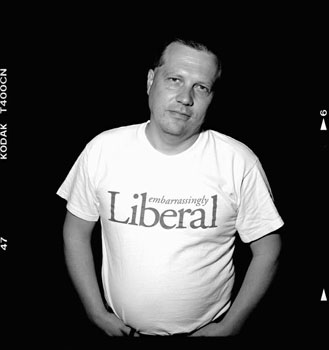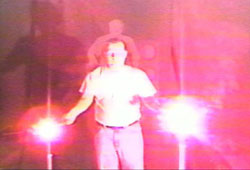Tim Kaiser
Electronic bard of Duluth


Tim Kaiser’s work is performance art, sculpture that happens in time, using electronic inventions, text, imagery, sound, actions. Kaiser has become a kind of electronic bard of his region, creating a persona of the artist as a maker of freedom, along with the idea that freedom is something you have to make personally. The history and cultures of this region, lived out through generations of Kaiser’s family, provide both raw and refined material for his mix of dark humor, formal beauty, and hellraising.
His moving works are mosaics of many smaller pieces, formally constructed, each bit of imagery, sound, text, notched into the whole. Threaded through this brocade of sound and video and live presence are his extraordinary texts, spare but with a passionate dark core, grittily lyrical.
It can be difficult to describe how Kaiser’s pieces work because they each have several levels going at once, and each level inflects the others in a kind of visual/verbal/sonic polyphony. In the course of one segment, “(R)Evolution,” Kaiser is speaking on stage flanked by wonderful changing video images of spinning clouds, of his own face becoming cloudlike by means of a pattern of shifting shadows, and of a fading image of his father standing, diffident, in the distance. Kaiser says then, in part, “In the words of my mother’s mother’s people, I have become a human being.” This referred to the passing and arrival of generations, the death of a father, the birth of sons. But it has a larger reference: Kaiser’s artmaking is about the work of becoming human.
I recently saw “Resonator,” at Grand Marais. A quote from the opening text: “Sometimes I imagine that long, long ago, before there were things — even before god — there was, at most, a sound: a wiggle . . . a vibration . . . a fading echo. Then something chemical, something quite electrical, became this rock. Then came time — then came toil — the moment-to-moment struggle that perhaps means nothing along the length of this line. Yet we pound the nail. We make big holes in the ground . . . and our ideas are like words in water.”